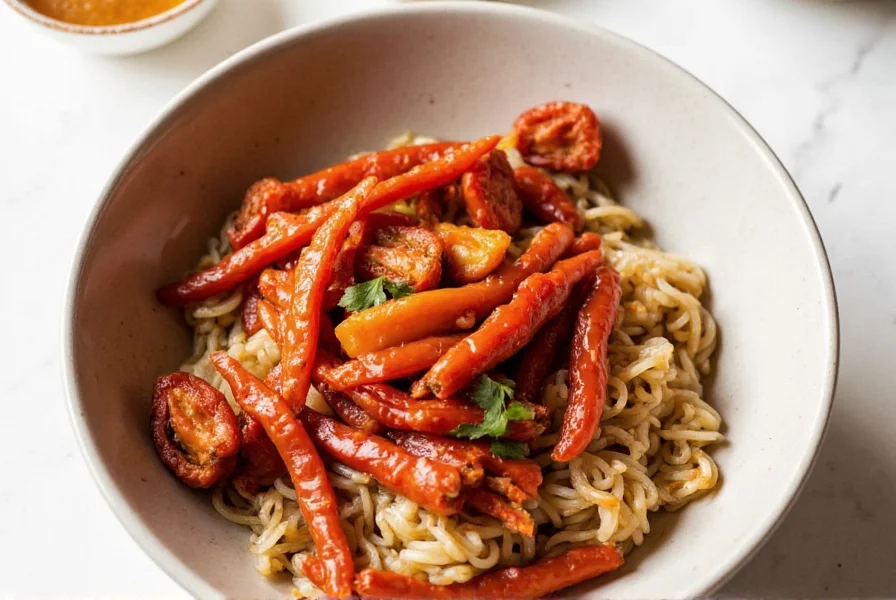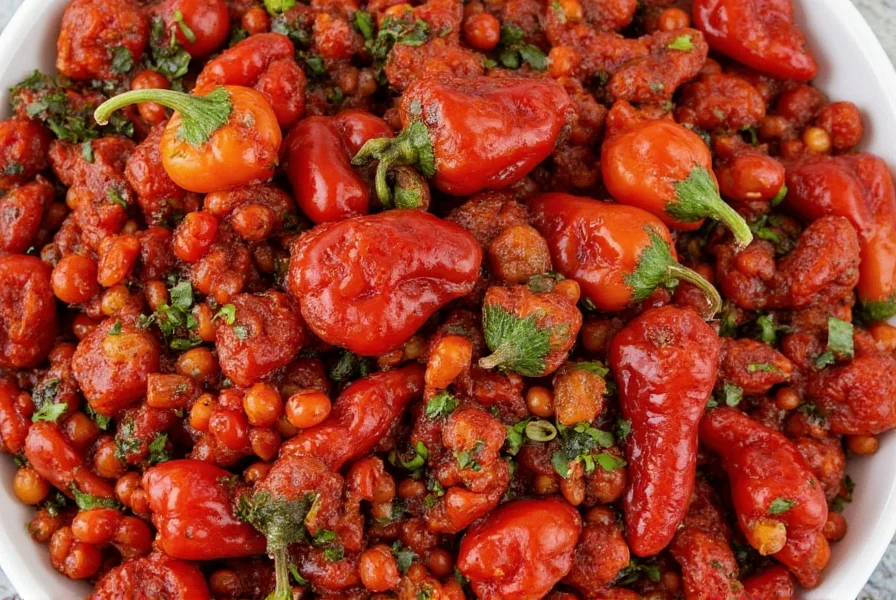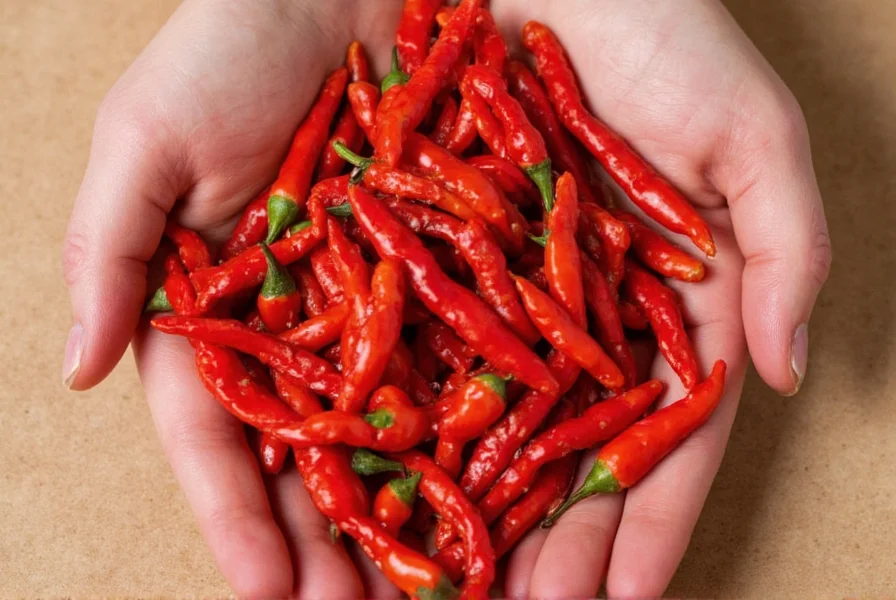Table of Contents
Introduction to Tien Tsin Pepper
Tien Tsin pepper delivers 100,000–200,000 Scoville Heat Units (SHU), placing it between cayenne and Thai bird's eye chilies in heat intensity. This Chinese chili variety is prized for its complex sweet-peppery flavor profile alongside intense heat, making it essential for authentic Asian cuisine. This comprehensive guide covers everything you need to know about selecting, using, and storing Tien Tsin pepper for optimal culinary results.
The Spice Profile of Tien Tsin Pepper
Tien Tsin pepper (Capsicum annuum) is a small but potent chili originating from China's Tianjin region. Its distinctive flavor combines sharp heat with subtle sweetness, creating a balanced profile that enhances rather than overwhelms dishes.
| Feature | Description |
|---|---|
| Origin | Tianjin, China |
| Heat Level | 100,000–200,000 Scoville Heat Units (SHU) |
| Flavor Profile | Peppery with sweet undertones |
| Size | 3–5 cm long, thin, pointed shape |
| Common Applications | Hot sauces, stir-fries, braises, marinades, chili oils |
Cooking Uses and Flavor Pairings
As a versatile ingredient in Chinese and Southeast Asian cooking, Tien Tsin pepper enhances dishes with its unique heat and flavor complexity. Here are professional culinary applications:
- Hot Sauces: Creates complex heat profiles when combined with vinegar, garlic, and fermented ingredients. Ideal for Sichuan-style sauces.
- Stir-Fries: Add whole or sliced peppers during the final cooking stage to preserve flavor and prevent burning.
- Marinades: Infuse meats with heat and depth when combined with soy sauce, ginger, and rice wine.
- Chili Oils: Essential for authentic Sichuan chili oil when infused in hot oil with Sichuan peppercorns.
- Braises: Whole peppers added to braising liquids impart gradual heat without overwhelming the dish.
Optimal flavor pairings include:
- Citrus elements (lime, lemon) to balance heat
- Garlic and ginger for aromatic complexity
- Soy sauce and fermented black beans for umami depth
- Shaoxing wine for traditional Chinese cooking
- Five-spice powder for complementary warmth
Practical Tips for Using Tien Tsin Pepper
Follow these expert techniques to maximize flavor and safety:
- Heat Control: Remove seeds and membranes for milder heat while retaining flavor complexity.
- Toast for Depth: Dry-toast whole peppers in a skillet for 30–60 seconds to enhance aroma before use.
- Fresh vs. Dried: Fresh peppers provide brighter heat for quick-cooking dishes; dried peppers offer concentrated flavor for slow-cooked applications.
- Storage: Keep fresh peppers in a paper bag in the refrigerator crisper drawer for up to 3 weeks. Dry peppers in airtight containers away from light for 6–12 months.
- Safety: Always wear gloves when handling and avoid touching your face. Wash hands thoroughly with soap after preparation.

Buying Guide: How to Choose the Best Tien Tsin Pepper
When purchasing Tien Tsin pepper, consider these quality indicators:
Key Selection Criteria
- Appearance: Bright red color with smooth, unwrinkled skin. Avoid peppers with dark spots or mold.
- Smell: Fresh, slightly sweet, and spicy aroma. Musty or sour smells indicate spoilage.
- Texture: Firm and plump with no soft spots. Dried peppers should be brittle but not crumbly.
Product Types Comparison
| Type | Best For | Storage Life | Flavor Profile |
|---|---|---|---|
| Fresh Tien Tsin | Quick-cooking dishes, garnishes | 2–3 weeks refrigerated | Bright, vibrant heat |
| Dried Whole Peppers | Infusions, braises, chili oils | 6–12 months | Concentrated, complex |
| Ground Powder | Spice blends, rubs, quick sauces | 3–6 months | Uniform heat distribution |
Recommended Purchasing Tips
- Choose reputable Asian grocery stores or specialty spice merchants for fresher products
- Check harvest dates—newer crops have superior flavor and heat
- For online purchases, verify seller reviews and check for proper packaging to prevent moisture exposure
Frequently Asked Questions
How hot is Tien Tsin pepper compared to other common chilies?
Tien Tsin pepper measures 100,000–200,000 Scoville Heat Units (SHU), making it 12–80 times hotter than jalapeños (2,500–8,000 SHU) and 2–6 times hotter than cayenne peppers (30,000–50,000 SHU). It falls between Thai bird's eye chilies (50,000–100,000 SHU) and habaneros (100,000–350,000 SHU) in heat intensity.
What are good substitutes for Tien Tsin pepper if I can't find it?
For similar heat and flavor complexity, use dried Thai chilies as a 1:1 substitute. For milder heat, combine cayenne pepper with a pinch of paprika to mimic the sweet undertones. Avoid using only cayenne alone, as it lacks the distinctive flavor profile of Tien Tsin.
Can I eat Tien Tsin peppers raw?
While technically edible raw, the intense heat makes this impractical for most palates. Raw consumption can cause severe discomfort and digestive issues. Always cook Tien Tsin peppers to mellow the heat and release their full flavor potential.
How should I store Tien Tsin peppers for maximum freshness?
For fresh peppers: Store in a paper bag in the refrigerator crisper drawer for 2–3 weeks. For dried peppers: Keep in an airtight container away from light and moisture for 6–12 months. Freezing fresh peppers in a sealed bag preserves quality for up to 1 year. Always label containers with the storage date.
Are Tien Tsin peppers the same as Chinese red peppers?
Tien Tsin is a specific variety of Chinese red pepper originating from Tianjin. While all Tien Tsin peppers are Chinese red peppers, not all Chinese red peppers are Tien Tsin. Tien Tsin has a distinct pointed shape and higher heat intensity (100k–200k SHU) compared to other Chinese red pepper varieties which typically range from 50k–100k SHU.
What's the best way to handle Tien Tsin peppers safely?
Always wear food-safe gloves when handling. Avoid touching your face, especially eyes. Use a sharp knife for precise cutting. After preparation, wash hands thoroughly with soap and warm water. If skin irritation occurs, apply milk or yogurt to neutralize capsaicin oils.
Can Tien Tsin peppers be grown at home?
Yes, Tien Tsin peppers thrive in USDA zones 9–11 or in containers moved indoors during cold weather. They require full sun (6–8 hours daily), well-draining soil, and consistent watering. Plants typically reach 18–24 inches tall and produce small, pointed peppers that ripen from green to bright red over 70–80 days.
Conclusion
Tien Tsin pepper's unique combination of intense heat (100k–200k SHU) and sweet-peppery complexity makes it an indispensable ingredient for authentic Asian cuisine. By understanding its proper handling, storage, and culinary applications, you can confidently incorporate this versatile chili into your cooking. Always prioritize quality sourcing and safety precautions to fully enjoy its distinctive flavor profile without overwhelming your dishes.












 浙公网安备
33010002000092号
浙公网安备
33010002000092号 浙B2-20120091-4
浙B2-20120091-4